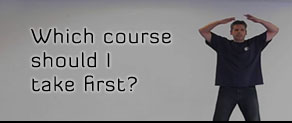The Standing Exercise is a nonexertion exercise, and unlike other forms of exercise, practice brings an alleviation of fatigue and an accumulation of energy, so that one feels refreshed and full of vitality and strength after practice. The basis of this phenomenon was explained as early as the 1920’s by the Chinese scholar Zhang Naiqi in his article “Towards a Scientific Interpretation of the Internal Martial Arts. He begins by investigating the real basis of fatigue, pointing out that it is not due to the simple energy required to perform an activity. He gives the example of walking. Say one walks a set distance of four miles at a steady three miles per hour, one would expect the same energy consumption and degree of fatigue each time. However, covering the distance while worrying about a deadline one must keep, or with a nagging pain in some part of the body will produce a much greater degree of fatigue than if one covers the distance chatting with friends or enjoying the good weather. He interprets fatigue as involving four elements:
- Tension in the torso.
- Tension in muscles not being moved or needed for movement – unnecessary fatigue.
- Excessive tension in muscles being used for movement -partially unnecessary fatigue.
- Energy consumption due to activity-necessary fatigue.
To this we could also add straight mental fatigue due to worry, thinking, etc. though as Zhang Naiqi again points out, much of this fatigue is the result of the unconscious physical tensions it produces. This tension is largely manifested in the torso, especially the chest (as well as the shoulders and face). One can feel for oneself how, when one is angry, agitated or excited, the chest is tense and constricted. This tension can be a severe restriction on respiration functions, impairing atrium activity and the exchange of oxygen, poisoning the whole metabolism. Necessary fatigue is that resulting from the muscular tension and energy expenditure required to perform an act. However, we often use excessive tension in doing this, and more importantly, do not just restrict this to the required parts, tensing other muscles unnecessarily. Lastly, we are constantly beset by unconscious muscular tensions. For instance, watching a fight or an exciting film, one tenses up; when writing one tenses the face or hunches the shoulders. Most noticeably, we maintain a constant inward and upward contraction of the stomach wall. This is to prevent the sinking down of the stomach and intestines, the artificial suspension of which feels normal due to conditioned reflex. This also further compounds tension in the chest. (A child’s chest and abdomen are relaxed. A series of painful or alarming experiences develops the tension reflex, which after a while becomes a conditioned state which feels normal.) All of these are tensions which place the body under considerable strain, impairing many of its functions and causing a great deal of unnecessary fatigue. Indeed, Zhang Naiqi points out that in most people, unnecessary fatigue probably outweighs necessary fatigue. The postures assumed during the practice of the Standing Pole Exercises are an excellent method of reducing this unnecessary fatigue by the conscious relaxation of tensions, especially those of the chest and abdomen. Steady practice will make this effect more permanent, extending outside practice into everyday life, so that such tensions are permanently reduced or eliminated. The increase in coordination and control from the exercises, especially through the process of relaxed movement, will teach the body to relax during activity, using only those muscles required with maximum efficiency. Thus, first during practice, then in everyday life and activity these unconscious and unnecessary tensions are eliminated, with the resulting conservation of energy. This is of enormous importance in the fight against illness, the nurturing of health and the development of strength.
As with any system of exercise, one should consult a doctor prior to initiating any exercise regimen. It is also advisable to find someone competent in instructing Zhang Zhuang Qigong or standing meditation to assist in postural alignment as well as addressing other personal issues that may need to be addressed.
[previous]






